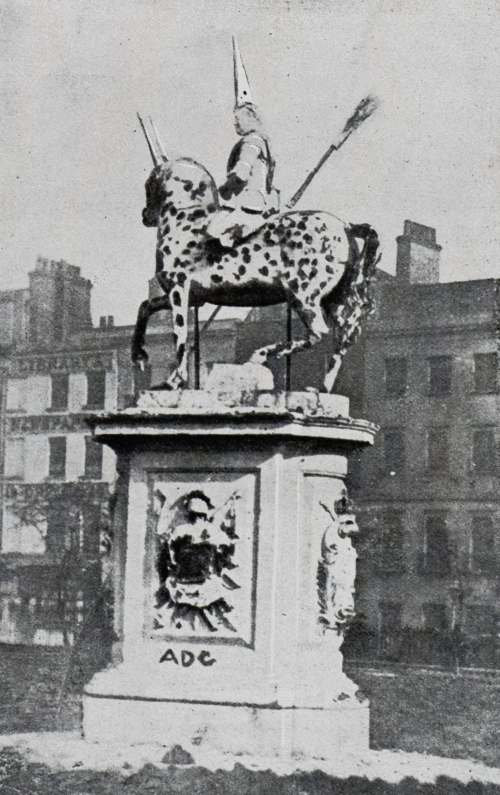The Equestrian Statue of George I.
Lead.
Wearing Modern Armour and Holding a Baton.
From Canons
Formerly in the garden of Leicester Square.
Cast by John van Nost II.
Set up in 1747.
The Country
Journal of Craftsmen, under the date of April 16, 1737, contains the
following statement:—"Leicester field is going to be fitted up in a very
elegant manner: a new wall and rails to be erected all round, and a basin in
the middle, after the manner of Lincoln's Inn Fields."
Northouck, in 1773,
writes:—"This is a handsome square, the inner part of which is enclosed by
iron rails, and adorned with grass plats and gravel walks. In the centre is an
equestrian statue of his present Majesty, gilt." This statue was really of
George I., modelled by C. Buchard for the Duke of Chandos, and brought from
Canons in 1747, when it was purchased by the inhabitants of the square. It was
finely gilt, and in 1812 was re-gilt.
For an interesting discussion on the origins of the statue see -
NOTES AND QUERIES: MEDIUM OF INTER-COMMUNICATION FOR
LITERARY MEN, ARTISTS, ANTIQUARIES, GENEALOGISTS, ETC. 1862 page 151.
_________________________________
Old and New
London: Volume 3. Originally published by Cassell, Petter &
Galpin, London, 1878.
On the
removal of Wyld's "Great Globe," after occupying the square for about
ten years, the enclosure became exposed once more in all its hideous nakedness.
From that time down to the middle of the year 1874, its condition was simply a
disgrace to the metropolis. Overgrown with rank and fetid vegetation, it was a
public nuisance, both in an æsthetic and in a sanitary point of view; covered
with the débris of tin pots and kettles, cast-off shoes, old
clothes, and dead cats and dogs, it was an eye-sore to every one forced to pass
by it.
As for the "golden horse and its rider," the effigy of George
I., which had been set up in the centre of the enclosure when Leicester House
was the "pouting place of princes," besides having suffered all the
inclemencies of the weather for years, it had become the subject of every
species of practical joke by almost every gamin in London.
The
horse is said to have been modelled after that of Le Sœur at Charing Cross;
whilst the statue of George I. was considered a great work of art in its day,
and was one of the sights of London, until after a quarter of a century of
humiliations, after being the standing butt of ribald caricaturists, and the
easy mark of witlings, it gradually fell to pieces.
The effigy of his Majesty
was the first to be assailed. His arms were first cut off; then his legs
followed suit, and afterwards his head; when the iconoclasts, who had doomed
him to destruction, at last dismounted him, propping up the mutilated torso
against the remains of the once caracolling charger on which the statue had
been mounted, and which was in nearly quite as dilapidated a plight.
It would
be almost impossible to tell all the pranks that were played upon this
ill-starred monument, and how Punch and his comic contemporaries
made fun of it, whilst the more serious organs waxed indignant as they dilated
on the unmerited insults to which it was subjected. One night a party of jovial
spirits actually whitewashed it all over, and daubed it ignominiously with
large black spots.

From Fun, 27th October 1866.
________________________________________
from Illustrated London News 11 March 1865.
_____________________________
Illustration from Punch 29 September 1866.
____________________________
Anon. Engraving.
17 October 1866.
Illustrated London News - 11 January 1868.
____________________________
Illustrated London News 10 February 1872.
The Last
of the Old Horse, in Leicester Square, London; from the picture by J O'Connor
in the Royal Academy, 1874. Published in Leicester Square; its associations and
its worthies. By Tom Taylor; published by Bickers and Son, 1 Leicester Square,
London, 1874.
All the above images lifted from


No comments:
Post a Comment